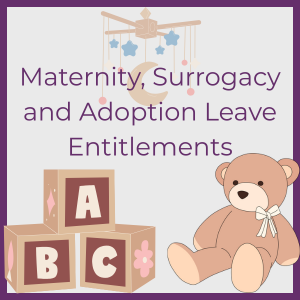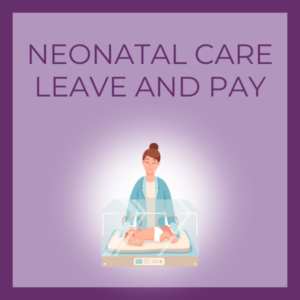Welcoming the arrival of a baby is always exciting but understanding the different options of leave available to an employee, and their rights during this time, can be confusing. Here we discuss everything you need to know about maternity, paternity, and shared parental leave.
Maternity Leave
How long is maternity leave and when does it start?
Statutory Maternity Leave runs for a period of 52 weeks and consists of Ordinary Maternity Leave “the first 26 weeks, and Additional Maternity Leave” the last 26 weeks. You are not obliged to take 52 weeks, but you must take a minimum of 2 weeks of leave after your baby is born (or 4 weeks if you work in a factory).

Normally, the earliest leave can start is 11 weeks before the week the child is due to be born. However, if a baby is born early or an employee is off work due to a pregnancy related illness, the maternity leave will start automatically.
What is Statutory Maternity Pay?
Statutory Maternity Pay is paid for up to 39 weeks and is broken down as follows:
- For the first six weeks, an employee will receive 90% (before tax) of their average weekly earnings
- For the next 33 weeks, an employee will receive either £151.97 or 90% of their average weekly earnings, whichever is lower
- Employees will be paid in the same way as their normal wages, (weekly or monthly) usually starting at the same time as the leave. It is important to remember that PAYE and National Insurance will still be deducted as applicable.
Who is eligible for Statutory Maternity Leave?
To qualify for Statutory Maternity Leave it does not matter how long you have been with your employer, how many hours you work or how much you get paid. However, you will need to be:
- An employee rather than a worker
- You must give your employer the correct notice
You can find out more about employment statuses on the government website here Employment status – GOV.UK (www.gov.uk).
Who is eligible for Statutory Maternity Pay?
To qualify for Statutory Maternity Pay, you will need to earning an average of £120 or more per week, give the correct notice to your employer along with proof that you are pregnant and have worked for your employer continuously for at least 26 weeks continuing into the qualifying week the 15th week before your baby expected due date.
If you earned less in some weeks because you were paid, but not working due to furlough then you may still be eligible.
Pay will not be given if you go into police custody during your maternity pay period and will not restart when you are discharged.
If an employee is not eligible for Statutory Maternity Pay under these rules, then the employer should ensure that they provide them with a form SMP1, which can be downloaded here Statutory Maternity Pay: employee not entitled form for employers – GOV.UK (www.gov.uk).
Paternity Leave
Who can take paternity leave and how long for?
An employee can take one or two weeks of paternity leave if they are considered to be an employee, as determined by their employment status, and give at least 15 weeks notice before the due date. They must also have been working for their employer for a period of 26 weeks consecutively.
When can an employee start their paternity leave?
Paternity leave can only start after the birth of a child. If an employee wants to change their start date for their leave, they must give 28 days notice. An employee cannot take shared parental leave and then take paternity leave.
Paternity pay:
Like statutory maternity pay, paternity pay is paid in the same way as an employee wages, and PAYE and National Insurance will be deducted.
An employee on paternity pay will receive £151.97 or 90% of their average weekly earnings – whichever is lower.
Who is eligible for paternity pay?
To receive statutory paternity pay, an employee must earn at least £120 a week (before tax). They must also have given at least 15 weeks notice and have worked for an employer for a period of 26 weeks continuously.
What are an employee’s rights during maternity or paternity leave?
While on maternity or paternity leave, an employee’s right to return to work, receive a pay rise and accrue holiday are protected.
An employee is also allowed unpaid time off to attend up to two antenatal appointments with their partner.
If an employee has taken only 26 weeks maternity leave, they will have the right to return to their original role. If the employee takes more than 26 weeks leave, then they will have the right to return to either their original role or a similar role (with the same or better terms and conditions) if it is not possible to give them their old job back.
Shared Parental Leave
What is shared parental leave?
Shared parental leave allows an employee more flexibility with when they return to work and allows them to spend time with their partner and their baby.
How much leave and pay is provided for shared parental leave?
An employee and their partner can share between them up to 50 weeks of leave and 37 weeks of pay. This must be done within the first year of the birth of a child.
During shared parental leave, an employee can choose to take their leave in blocks, in between periods of work, or all at once. An employee may choose to take shared parental leave and pay at the same time as their partner, or to stagger it.
Who is entitled to Shared Parental Leave and pay?
To qualify, both the employee and their partner must be responsible for the child at the time of their birth. Both will also need to meet specific work and pay criteria which will differ depending on who is intending to use the shared parental leave and pay.
To be eligible for Shared Parental Pay, both parents must earn on average at least £120 per week.
The mother and mother’s partner must also meet the following eligibility requirements:
The mother must:
- Have been working for at least 26 weeks out of the 66 weeks before the baby’s due date (the 26 weeks do not need to be consecutive)
- Have earned at least £390 in total across any 13 of the 66 weeks
The mother’s partner must:
- Have been employed continuously by the same employer for at least 26 weeks by the end of the 15th week before the due date
- Stay with the same employer until they start their leave
Can an employee take maternity leave and shared parental leave?
If an employee ends their maternity leave early, they can take the remaining leave and pay as shared parental leave instead. More information about shared parent leave can be found on the government’s website here https://www.gov.uk/shared-parental-leave-and-pay/eligibility-for-birth-parents.
Further information:
Those who are welcoming a child through adoption or surrogacy are also entitled to similar leave and pay. More information can be found at https://www.gov.uk/paternity-pay-leave/adoption.
If you have any questions about managing your staff’s maternity, paternity, or shared parental leave, please get in touch with our expert bookkeepers and payroll team, by calling 01892 559490 or via our online enquiry form.







